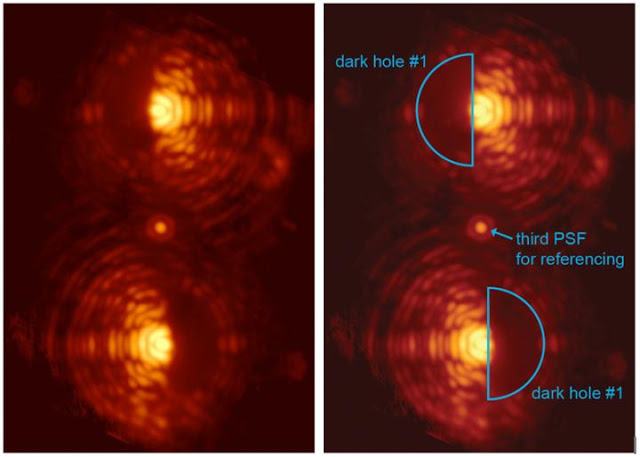| Online: | |
| Visits: | |
| Stories: |

| Story Views | |
| Now: | |
| Last Hour: | |
| Last 24 Hours: | |
| Total: | |
New Optic Detects Exoplanets Close to Their Host Star
This is a double image of the star Eta Crucis taken through the vector-APP coronagraph installed at MagAO. The two main images of the star exhibit D-shaped dark holes on complementary sides.

Credit: Leiden University, University of Arizona
Almost 2000 exoplanets have been detected to date, but only a handful of those have been imaged directly. Exoplanets are typically more than a million times fainter than and are lost in the glare of their parent star as seen from Earth. To directly image exoplanets and to characterize their atmospheres, astronomical instruments at the world’s largest telescopes use coronagraphs to suppress the overwhelming halo of light from the star.
This is a double image of the star beta Centauri taken through an experimental version of the vector-APP coronagraph installed at MagAO. Both images of the star contain a dark region that covers the complete 360 degrees around the central star. In both cases, the binary companion to beta Centauri is easily detected.
The vector-APP coronagraph[1] uses the wavelike nature of light to cancel out the starlight whilst allowing the planet’s light to shine through.
This manipulation is implemented through a complex phase pattern that can only be manufactured using advanced liquid crystal 3D patterning techniques [2]. This technique creates two images of the star, for which dark D-shaped regions are located on opposite sides of each star image (see Figure 1). In this way, the whole region around the star can be scrutinized for planets. By combining several layers of liquid crystals, the device can be used over a wide range of wavelengths, including the infrared where the contrast between planet and star is more favorable.
On May 6, 2015 a vector-APP coronagraphic device saw first light (at 3.9 m wavelength, in the infrared range of the spectrum) at the MagAO[3] instrument, attached to the 6.5-m diameter Magellan Clay telescope in Chile. The telescope’s integrated adaptive optics system provided the instrument with sharp images of stars, which were consequently split up and modified by the coronagraph to exhibit dark holes in which much fainter planets could be imaged than without the vector-APP coronagraph.
Frans Snik, who invented the principle behind the new vector-APP coronagraph, says: ”It is fantastic to see that after all our design work and lab testing, this new approach works perfectly at the telescope on the very first night!”
Gilles Otten adds: ”We knew that we were in business as soon as we saw the first picture on the screen in the telescope control room.”
Jared Males is excited about the opportunities of the vector-APP:
“With this new coronagraph we are now looking for planets around nearby stars. We have the capacity to directly detect, or rule out, planets smaller than Jupiter.”
Matthew Kenworthy concludes: ”This new coronagraph technology is also excellent news for the extremely large telescopes currently under construction. Thermal infrared instruments such as the Mid-infrared E-ELT Imager and Spectrograph (METIS) can exploit this new technology and discover new worlds. With a vector-APP coronagraph in the next generation of telescopes, we can search for planets around nearby stars with unprecedented sensitivity.”
The advanced liquid crystal technology that the team adopted also permitted the production of extreme vector-APP designs that are not possible with more traditional manufacturing technologies. These new designs produce dark holes that cover the full 360 degrees around the target stars. The first data from an experimental device already shows the viability of this novel approach.
Contacts and sources:
Olivier Hernandez
Source:




